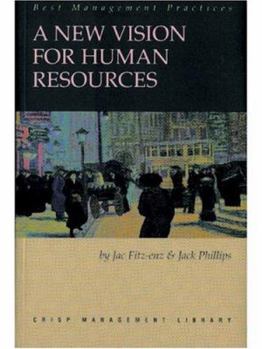A New Vision for Human Resources: Crisp Management Library
Select Format
Select Condition 
Book Overview
The authors argue that many of our best organizations have come to realize that people are the only dynamic asset in the mix and that Human Resource professionals must begin to align their goals with... This description may be from another edition of this product.
Format:Paperback
Language:English
ISBN:156052488X
ISBN13:9781560524885
Release Date:January 1999
Publisher:Crisp Learning
Length:119 Pages
Weight:0.37 lbs.
Dimensions:0.4" x 5.4" x 8.4"
Customer Reviews
2 ratings
And well written too.
Published by Thriftbooks.com User , 21 years ago
Turgay gets it right.A few other observations...It is very well written. Terse, no padding, well structured. You can get through it in an hour, cover to cover. It is actionable. Everything discussed is straightforward to execute. It is realistic. Fritz-Heinz and Phillips embrace HR politics. It is ambitious. If you're taking care of ordinary HR administrivia without a sweat, this is your roadmap, a framework for getting you to the next level. I like their ten measures of effectiveness:10. Healthcare cost per employee.9. Pay and benefits as a percentage of operating expense.8. Cost per hire.7. Return on training.6. Turnover rate. 5. Turnover cost. 4. Time to fill jobs. 3. Return on human capital invested.2. Human value added. 1. The one that means the most to your boss.It's a pearl.
The HR Star.
Published by Thriftbooks.com User , 23 years ago
"In business we've stopped talking about personnel administration or even human resources management. Now we are dealing with the management of human capital...and human resources is right in the middle of it. It is no longer a cliche to say that people are the most important asset of an organization. People are the only dynamic asset. People are the causal force. Nothing happens without people. The human resources department's role is to help people be more effective in their work, as well as more satisfied. This effectiveness imperative is not measured in a flurry of programs. It is found in business results" (pp.1-2).In this context, in Chapter VII, Jac Fitz-enz and Jack Phillips write that "As companies adjust to the new forces of the twenty-first century, HR has to find a basic model for staying in alignment with its customers. In times of great flux and uncertainty, the best approach is usually the simplest and closest to bedrock management. Basically, the human resources function has five responsibilities: planning, staffing, paying, developing and retaining human capital." Thus, in order to reveal interdependence among these functions, they introduce the HR Star model as following:1. Workforce Planning- WFP is making a comeback. No matter what size your organization is, you have to look ahead to your future skills profile. If you devote a reasonable amount of time to planning, you will have it returned in reduced hiring time and cost, lower training costs of new employees, and probably higher productivity through a more stable and motivated workforce.2. Staffing- Hiring during periods of sustained high growth becomes an all-consuming task. The only thing that will make it easier is having good data on the results of your current practices. Doesn't it make sense that if you know how much it costs, how long it takes, and the quality and availability of each of your major sources, you can do a better job?3. Paying- Pay covers wages, salaries and benefits-the total cash investment in human assets. We can do a better job of managing that investment if we look at it from a resource viewpoint.4. Developing- Employee development is no longer an option. Basic skills, management competencies and executive development are all priorities. If we don't develop effective leaders, we won't have to worry about basic skills because we will be out of business.5. Retaining- When the supply is limited, a wise strategy is to pay attention to keeping what you have. Consider what it costs to lose a skilled employee: the direct cost of termination, hiring a replacement, vacancy costs and learning curve loss. These add up to more than one year's pay and benefits for an exempt person. Add to that the external costs in unhappy and lost customers, and the number goes out of sight. One study claims that the cost of losing an effective salesperson can take up to three years to recover.Highly recommended.




